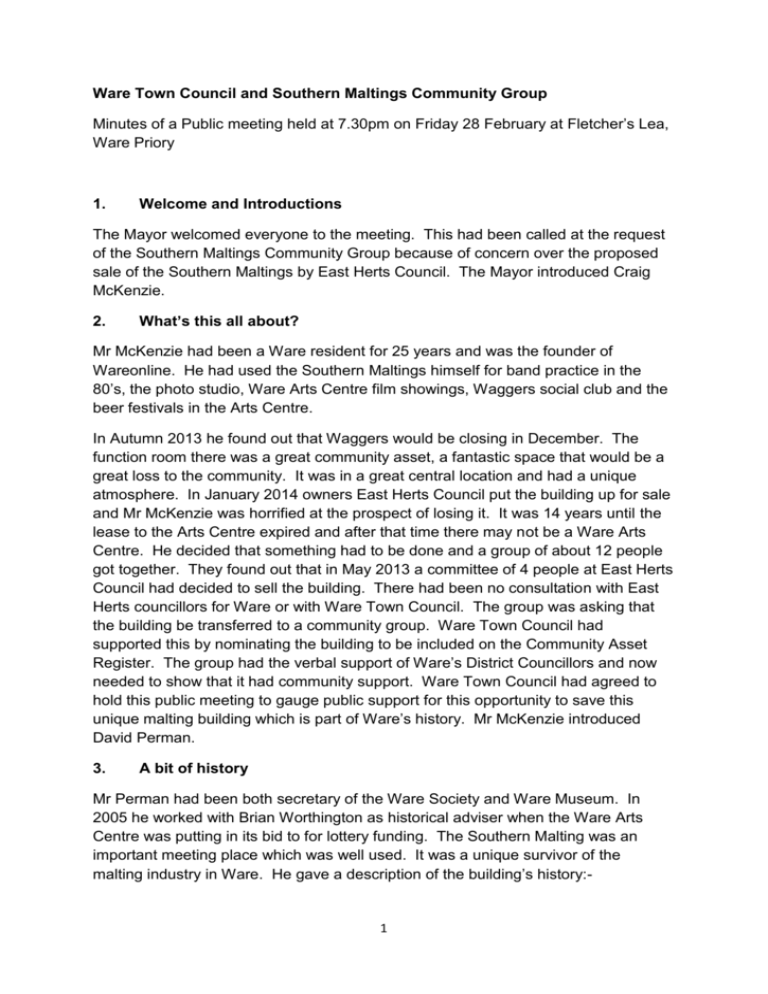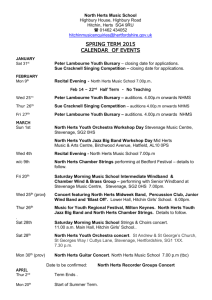Ware Town Council and Southern Maltings Community Group
advertisement

Ware Town Council and Southern Maltings Community Group Minutes of a Public meeting held at 7.30pm on Friday 28 February at Fletcher’s Lea, Ware Priory 1. Welcome and Introductions The Mayor welcomed everyone to the meeting. This had been called at the request of the Southern Maltings Community Group because of concern over the proposed sale of the Southern Maltings by East Herts Council. The Mayor introduced Craig McKenzie. 2. What’s this all about? Mr McKenzie had been a Ware resident for 25 years and was the founder of Wareonline. He had used the Southern Maltings himself for band practice in the 80’s, the photo studio, Ware Arts Centre film showings, Waggers social club and the beer festivals in the Arts Centre. In Autumn 2013 he found out that Waggers would be closing in December. The function room there was a great community asset, a fantastic space that would be a great loss to the community. It was in a great central location and had a unique atmosphere. In January 2014 owners East Herts Council put the building up for sale and Mr McKenzie was horrified at the prospect of losing it. It was 14 years until the lease to the Arts Centre expired and after that time there may not be a Ware Arts Centre. He decided that something had to be done and a group of about 12 people got together. They found out that in May 2013 a committee of 4 people at East Herts Council had decided to sell the building. There had been no consultation with East Herts councillors for Ware or with Ware Town Council. The group was asking that the building be transferred to a community group. Ware Town Council had supported this by nominating the building to be included on the Community Asset Register. The group had the verbal support of Ware’s District Councillors and now needed to show that it had community support. Ware Town Council had agreed to hold this public meeting to gauge public support for this opportunity to save this unique malting building which is part of Ware’s history. Mr McKenzie introduced David Perman. 3. A bit of history Mr Perman had been both secretary of the Ware Society and Ware Museum. In 2005 he worked with Brian Worthington as historical adviser when the Ware Arts Centre was putting in its bid to for lottery funding. The Southern Malting was an important meeting place which was well used. It was a unique survivor of the malting industry in Ware. He gave a description of the building’s history:- 1 This is one of three parallel maltings behind the Kibes Lane carpark. The northern two maltings are in private ownership but the Southern Malting has been owned by East Herts District Council since its inception in 1974. Malt production was carried on in the Southern Malting from about 1838 until 1950, when the building was used by Thorn Electrics for the storage of television sets. This site has been associated with the malting industry since the eighteenth century, being originally part of the malting yard of the Dickenson family before New Road was built across their land in the 1830’s. The present building, constructed in yellow brick, dates from the late 1830’s and was intended for the production of “brown malt” used in the brewing of “porter beer”. At that time – with the coming of the railways – the Hertfordshire malting industry was in fierce competition with the maltsters of Newark, who supplied malt to the brewers of Burton-on-Trent. These brick maltings therefore incorporated a great deal of up-to-date Victorian technology. The kilns had wire floors, held in place by iron bars which were fixed on the outside by tie plates. The tie plates bearing the name Charles Wells are still visible. Charles Wells ran the Falcon Ironworks in Ware High Street and specialised in fittings for the malting industry. The swivelling cowls above the kilns were also a Charles Wells invention – before his time, cowls were of the fixed “mortar board” design. The interior of the Southern Malting still has the three malt floors in place, with a barley store and steeping chamber at the west end and the kilns at the east end. The wire floor of the kiln can still be seen from the ground floor and the inside of the cowls from the first floor. The kilns and the malt store at the west end now form the Ware Arts Centre, which in 2005 carried out a thorough refurbishment and restoration on two floors with funding mainly from the Heritage Lottery Fund. In preparation for that project, the Arts Centre trustees signed a 25 year lease for that part of the building with East Herts Council. The ground floor of the remainder of the building was used until 2013 by Mr. Peter Smith as Waggers Social Club. The Southern Malting is the last surviving historic malting in Ware with its kilns in place – in the 1880’s there were well over 100 malthouses in the town, many with more than one kiln. This is a unique survivor of a once nationally important industry. The Southern Malting is listed Grade II by English Heritage. 4. What can we use it for? Mr McKenzie asked the community for ideas about what the building could be used for. He suggested that this would not be a pub as Waggers had had to close. The following suggestions were made: Workshops for artists and craftspeople partitioned into small studios and a café bar area A heritage centre for the malting industry Extension to Ware Museum Extension to Ware Arts Centre 2 Community kiln The upstairs area could be a money generating area as it had capacity for events for up to 200 people Indoor market Dances and dance classes Live music venue Rehearsal space, perhaps for Ware Operatic Society and Ware Brass Theatre Multi-use area for theatre, live music etc Have a replica of the Great Bed or try and get the Great Bed back and the museum would be the focal point of other uses – noted that if the museum moved completely it would have to pay back lottery grants used for improvements Community run micro-brewery There was a need to get a group together to take this forward and volunteers were needed from the community to assist with projects. He was looking for agreement to take this forward. He introduced Cllr John Wing. 5. The constitution and invites to join Cllr Wing said that Ware Town Council had made an application on behalf of the town to put the building on the Community Asset Register. To date 4 applications had been made and all had been denied. If this application was not accepted then he could not imagine what would be so he was confident it would be registered. This would stop the sale of the building for a 6 month period. The group would need to negotiate with East Herts Council to acquire the freehold or leasehold. Cllr Wing thought East Herts Council wanted to relinquish the freehold as they did not want continuing responsibility for maintenance. The group would need to develop a business plan for use of the building. The guide price for purchasing the building was £650,000 and it was unrealistic to try and raise this in such a short period. This morning he had obtained information from a former Finance Officer of Ware Urban District Council who was involved in the work to move from 6 urban and rural district councils to East Herts District Council in 1974. He said the maltings were made as a gift to Ware Urban District Council. Cllr Wing did not know if this was true or still relevant but if it was a gift for the benefit of the people of Ware it is in the same position as the Priory was. 2 councillors went to court on behalf of Ware Town Council for the Priory to be recognised by the High Court as in the ownership of Ware Town Council and not East Herts Council. He needed to follow this up but it would involve negotiation with East Herts Council and two of the maltings had already been sold. Cllr Wing passed round copies of the draft constitution which was based on those of other community organisations in Ware. It proposed that the Southern Malting 3 Community Group act as a body to negotiate with East Herts Council and to manage and sustain the malting into the future. He was proposing setting up an Executive Committee consisting of a Chairman, Vice Chairman, Secretary, Treasurer and 8 other members. He suggested holding the group’s first Annual General Meeting in about one month’s time to fill these executive positions. All those who had signed the attendance sheet tonight would be contacted with notice of the meeting. The meeting was then opened up for questions and comments. Colin Lovatt considered the running costs must be very high and was concerned about what condition the roof, electrics and structure of the building were in. Cllr Wing agreed that these concerns must be foremost in mind when taking on a building. He had had conversations with two builders and an electrician to try to gauge costs of long-term maintenance. He was trying to find out the cost of recovering the roof and this is something that would only need doing every 80 to 100 years. The Arts Centre had been rewired and the builder considered this to be in good condition. The work in Waggers had been carried out to a very high standard and the builder also considered this to be in good condition. He would not take on an old building without looking at how much needed doing on a long-term basis. He though there was capacity to raise money through regular use and pointed out that Waggers had been able to pay a rent of £20,000 from their profits. Mr Perman raised concern that East Herts Council had refused previous applications for assets to be included on the Community Asset Register. This nomination would stop East Herts Council from selling the building and he thought it should go to the Secretary of State. He was concerned that a developer would be able to get round it being included on the list. The Buryfields had been given to the people of Ware but a judge had ruled that this should stay with East Herts Council in the interests of the local economy. Cllr Phyllis Ballam believed that as East Herts Council owned the building in question the application for nomination on the Community Asset Register would have to be decided by a neighbouring authority. Peter Smith said he was a member of Ware Operatic Society which meets at Ware Arts Centre twice a week and he was sure they would give considerable assistance to the group. This was reinforced by Molly Smith who said the refurbishment had transformed it into a lovely venue and it would be criminal if it was bulldozed over. Rose Ferguson noted that if the nomination was successful it would lead to a 6 month delay of the sale and she was concerned that as part of austerity measures that the sale could be part of East Herts Council’s strategy for saving. The group would need to have a strategy to stop that. Ian Ball asked if anyone had looked into whether East Herts Council had the constitutional right to sell a community asset. Maurice Warner owned the malting next door and agreed with David Perman about East Herts Council. He remembered the Southern Malting being put right and had 4 confidence that he building was in good condition. It should be used and kept for the people of Ware. Cllr Mark Pope did not believe that East Herts Council was selling the building in order to raise funds as they had considerable reserves. It was more likely to be so that they did not have to be responsible for it in the future. He was in favour of what the group was trying to do and had contacted the Leader of East Herts Council and the Executive member for finance asking to discuss it but he had not yet had a reply. East Herts Council was short of revenue funding not capital. Josie Fish suggested that if East Herts Council would not register the building as a community asset could we apply to the Heritage Lottery fund for a grant towards the purchase of the building as it was one of the few maltings remaining in Hertfordshire. Jan Wing explained why we should be fighting for the maltings. The Draft District Plan was now out for consultation. If Ware had to take more than its share of housing then it would be counterproductive to lose a community building when new residents would need community facilities and would look to Ware as a centre. The group needed to marry up its arguments with the District Plan consultation. A unique community facility should not be lost. John Beech asked what relationship Ware Town Council would have with the group. The Mayor said that the minutes of tonight’s meeting would go to the next full Council meeting on 24 March to decide whether to appoint a Council representative to the group. Representations in response to the nomination for the building to be included on the Community Asset Register had to be with East Herts Council by 28 March and she urged people attending to make individual representations. The minutes of this meeting would also be given to the group to make representations. Sylvia Hovell asked Ware Town Council to hold an extraordinary meeting to consider its representation. Cllr Pope pointed out that Ware Town Council had already given support by nominating the asset for inclusion on the Community Asset Register and holding this public meeting. The Town Clerk said that Ware Town Council had already made its representation to East Herts Council by sending in the nomination form and accompanying letter. Mrs Hovell asked for Cllr Jeanette Taylor’s views. Cllr Taylor an East Herts District Councillor and County Councillor said she was here to listen tonight and this issue had not yet come to East Herts Council. Rosie Ferguson asked if a template representation could be sent to everyone. Cllr Wing gave the address for people to write to and said he could email all those present with the reply details and a list of points that could be made but it usually 5 received a better response if people wrote individual letters rather than one standard one. He said that although Ware’s councillors on East Herts Council supported this, the town had 7 councillors in a council of 50. Colin McIntyre asked how we could ensure that Ware’s councillors on East Herts Council would support them. The Mayor advised lobbying them. A vote was taken on whether to set up a community group to acquire the Southern Maltings for Ware. All were in favour except for Cllr Taylor who abstained. It was agreed to acquire the Southern Maltings for Ware. It was agreed that Craig McKenzie would act as interim Chairman. Mr McKenzie asked all those interested in joining the group to introduce themselves after the meeting. 6. Summation and close of meeting The Mayor thanked everyone for attending and closed the meeting at 8.35pm. 6






